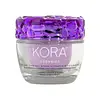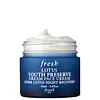What's inside
What's inside
 Key Ingredients
Key Ingredients

 Benefits
Benefits

 Concerns
Concerns

 Ingredients Side-by-side
Ingredients Side-by-side

Aloe Barbadensis Leaf Juice
Skin ConditioningGlycerin
HumectantCetearyl Alcohol
EmollientCoconut Alkanes
EmollientWater
Skin ConditioningHelianthus Annuus Flower
Skin ConditioningLactobacillus Ferment
Skin ConditioningSorbitan Olivate
EmulsifyingCetearyl Olivate
Butyrospermum Parkii Butter
Skin ConditioningEuterpe Oleracea Fruit Extract
Bakuchiol
AntimicrobialRosa Canina Fruit Oil
EmollientLactobacillus
Skin ConditioningCeramide NP
Skin ConditioningCoco-Caprylate/Caprate
EmollientEragrostis Tef Seed Extract
EmollientSclerotium Gum
Emulsion StabilisingCocos Nucifera Fruit Extract
EmollientPotassium Sorbate
PreservativeMedicago Sativa Extract
TonicEclipta Prostrata Extract
Skin ConditioningCitric Acid
BufferingMelia Azadirachta Leaf Extract
Skin ConditioningPelargonium Graveolens Flower Oil
MaskingSodium Phytate
Citrus Aurantium Amara Flower Oil
MaskingMelia Azadirachta Flower Extract
Skin ConditioningCorallina Officinalis Extract
Skin ConditioningSodium Benzoate
MaskingMorinda Citrifolia Fruit Extract
Skin ConditioningCoccinia Indica Fruit Extract
Skin ConditioningTocopherol
AntioxidantMoringa Oleifera Seed Oil
EmollientSolanum Melongena Fruit Extract
Skin ConditioningAloe Barbadensis Flower Extract
EmollientSimmondsia Chinensis Seed Oil
EmollientCurcuma Longa Root Extract
MaskingOcimum Basilicum Flower/Leaf Extract
TonicOcimum Sanctum Leaf Extract
Skin ConditioningAlcohol
AntimicrobialLinalool
PerfumingCitronellol
PerfumingGeraniol
PerfumingLimonene
PerfumingFarnesol
PerfumingAloe Barbadensis Leaf Juice, Glycerin, Cetearyl Alcohol, Coconut Alkanes, Water, Helianthus Annuus Flower, Lactobacillus Ferment, Sorbitan Olivate, Cetearyl Olivate, Butyrospermum Parkii Butter, Euterpe Oleracea Fruit Extract, Bakuchiol, Rosa Canina Fruit Oil, Lactobacillus, Ceramide NP, Coco-Caprylate/Caprate, Eragrostis Tef Seed Extract, Sclerotium Gum, Cocos Nucifera Fruit Extract, Potassium Sorbate, Medicago Sativa Extract, Eclipta Prostrata Extract, Citric Acid, Melia Azadirachta Leaf Extract, Pelargonium Graveolens Flower Oil, Sodium Phytate, Citrus Aurantium Amara Flower Oil, Melia Azadirachta Flower Extract, Corallina Officinalis Extract, Sodium Benzoate, Morinda Citrifolia Fruit Extract, Coccinia Indica Fruit Extract, Tocopherol, Moringa Oleifera Seed Oil, Solanum Melongena Fruit Extract, Aloe Barbadensis Flower Extract, Simmondsia Chinensis Seed Oil, Curcuma Longa Root Extract, Ocimum Basilicum Flower/Leaf Extract, Ocimum Sanctum Leaf Extract, Alcohol, Linalool, Citronellol, Geraniol, Limonene, Farnesol
Water
Skin ConditioningGlycerin
HumectantIsononyl Isononanoate
EmollientGlyceryl Stearate
EmollientCaprylic/Capric Triglyceride
MaskingButylene Glycol
HumectantPentylene Glycol
Skin ConditioningC10-18 Triglycerides
EmollientDiglycerin
HumectantButyrospermum Parkii Butter
Skin ConditioningPEG-100 Stearate
Myristyl Myristate
EmollientNelumbo Nucifera Extract
Skin ConditioningPrunus Persica Leaf Extract
EmollientCitrus Limon Peel Oil
MaskingCucumis Sativus Fruit Extract
EmollientNelumbo Nucifera Flower Extract
Skin ConditioningAnthemis Nobilis Flower Oil
MaskingTocopheryl Acetate
AntioxidantTocopherol
AntioxidantBehenyl Alcohol
EmollientAmmonium Acryloyldimethyltaurate/Beheneth-25 Methacrylate Crosspolymer
Emulsion StabilisingCetearyl Alcohol
EmollientCetyl Palmitate
EmollientCocoglycerides
EmollientAcrylates/C10-30 Alkyl Acrylate Crosspolymer
Emulsion StabilisingParfum
MaskingSodium Hydroxide
BufferingT-Butyl Alcohol
PerfumingSodium Metabisulfite
AntioxidantBHT
AntioxidantTetrasodium EDTA
Ethylhexylglycerin
Skin ConditioningPotassium Sorbate
PreservativeSodium Benzoate
MaskingPhenoxyethanol
PreservativeLimonene
PerfumingBenzyl Salicylate
PerfumingCitral
PerfumingWater, Glycerin, Isononyl Isononanoate, Glyceryl Stearate, Caprylic/Capric Triglyceride, Butylene Glycol, Pentylene Glycol, C10-18 Triglycerides, Diglycerin, Butyrospermum Parkii Butter, PEG-100 Stearate, Myristyl Myristate, Nelumbo Nucifera Extract, Prunus Persica Leaf Extract, Citrus Limon Peel Oil, Cucumis Sativus Fruit Extract, Nelumbo Nucifera Flower Extract, Anthemis Nobilis Flower Oil, Tocopheryl Acetate, Tocopherol, Behenyl Alcohol, Ammonium Acryloyldimethyltaurate/Beheneth-25 Methacrylate Crosspolymer, Cetearyl Alcohol, Cetyl Palmitate, Cocoglycerides, Acrylates/C10-30 Alkyl Acrylate Crosspolymer, Parfum, Sodium Hydroxide, T-Butyl Alcohol, Sodium Metabisulfite, BHT, Tetrasodium EDTA, Ethylhexylglycerin, Potassium Sorbate, Sodium Benzoate, Phenoxyethanol, Limonene, Benzyl Salicylate, Citral
Ingredients Explained
These ingredients are found in both products.
Ingredients higher up in an ingredient list are typically present in a larger amount.
This ingredient is also known as shea butter. It is an effective skin hydrator and emollient.
Emollients help soothe and soften your skin. It does this by creating a protective film on your skin. This barrier helps trap moisture and keeps your skin hydrated. Emollients may be effective at treating dry or itchy skin.
Shea butter is rich in antioxidants. Antioxidants help fight free-radicals, or molecules that may harm the body. It is also full of fatty acids including stearic acid and linoleic acid. These acids help replenish the skin and keep skin moisturized.
While Shea Butter has an SPF rating of about 3-4, it is not a sunscreen replacement.
Shea butter may not be fungal acne safe. We recommend speaking with a professional if you have any concerns.
Learn more about Butyrospermum Parkii ButterCetearyl alcohol is a mixture of two fatty alcohols: cetyl alcohol and stearyl alcohol. It is mainly used as an emulsifier. Emulsifiers help prevent the separation of oils and products. Due to its composition, it can also be used to thicken a product or help create foam.
Cetearyl alcohol is an emollient. Emollients help soothe and hydrate the skin by trapping moisture.
Studies show Cetearyl alcohol is non-toxic and non-irritating. The FDA allows products labeled "alcohol-free" to have fatty alcohols.
This ingredient is usually derived from plant oils such as palm, vegetable, or coconut oils. There is debate on whether this ingredient will cause acne.
Due to the fatty acid base, this ingredient may not be Malassezia folliculitis safe.
Learn more about Cetearyl AlcoholGlycerin is already naturally found in your skin. It helps moisturize and protect your skin.
A study from 2016 found glycerin to be more effective as a humectant than AHAs and hyaluronic acid.
As a humectant, it helps the skin stay hydrated by pulling moisture to your skin. The low molecular weight of glycerin allows it to pull moisture into the deeper layers of your skin.
Hydrated skin improves your skin barrier; Your skin barrier helps protect against irritants and bacteria.
Glycerin has also been found to have antimicrobial and antiviral properties. Due to these properties, glycerin is often used in wound and burn treatments.
In cosmetics, glycerin is usually derived from plants such as soybean or palm. However, it can also be sourced from animals, such as tallow or animal fat.
This ingredient is organic, colorless, odorless, and non-toxic.
Glycerin is the name for this ingredient in American English. British English uses Glycerol/Glycerine.
Learn more about GlycerinLimonene is a fragrance that adds scent and taste to a formulation.
It's found in the peel oil of citrus fruits and other plants such as lavender and eucalyptus. The scent of limonene is generally described as "sweet citrus".
Limonene acts as an antioxidant, meaning it helps neutralize free radicals.
When exposed to air, oxidized limonene may sensitize the skin. Because of this, limonene is often avoided by people with sensitive skin.
The term 'fragrance' is not regulated in many countries. In many cases, it is up to the brand to define this term. For instance, many brands choose to label themselves as "fragrance-free" because they are not using synthetic fragrances. However, their products may still contain ingredients such as essential oils that are considered a fragrance.
Learn more about LimonenePotassium Sorbate is a preservative used to prevent yeast and mold in products. It is commonly found in both cosmetic and food products.
This ingredient comes from potassium salt derived from sorbic acid. Sorbic acid is a natural antibiotic and effective against fungus.
Both potassium sorbate and sorbic acid can be found in baked goods, cheeses, dried meats, dried fruit, ice cream, pickles, wine, yogurt, and more.
You'll often find this ingredient used with other preservatives.
Learn more about Potassium SorbateSodium Benzoate is a preservative. It's used in both cosmetic and food products to inhibit the growth of mold and bacteria. It is typically produced synthetically.
Both the US FDA and EU Health Committee have approved the use of sodium benzoate. In the US, levels of 0.1% (of the total product) are allowed.
Sodium benzoate works as a preservative by inhibiting the growth of bacteria inside of cells. It prevents the cell from fermenting a type of sugar using an enzyme called phosphofructokinase.
It is the salt of benzoic acid. Foods containing sodium benzoate include soda, salad dressings, condiments, fruit juices, wines, and snack foods.
Studies for using ascorbic acid and sodium benzoate in cosmetics are lacking, especially in skincare routines with multiple steps.
We always recommend speaking with a professional, such as a dermatologist, if you have any concerns.
Learn more about Sodium BenzoateTocopherol (also known as Vitamin E) is a common antioxidant used to help protect the skin from free-radicals and strengthen the skin barrier. It's also fat soluble - this means our skin is great at absorbing it.
Vitamin E also helps keep your natural skin lipids healthy. Your lipid skin barrier naturally consists of lipids, ceramides, and fatty acids. Vitamin E offers extra protection for your skin’s lipid barrier, keeping your skin healthy and nourished.
Another benefit is a bit of UV protection. Vitamin E helps reduce the damage caused by UVB rays. (It should not replace your sunscreen). Combining it with Vitamin C can decrease sunburned cells and hyperpigmentation after UV exposure.
You might have noticed Vitamin E + C often paired together. This is because it is great at stabilizing Vitamin C. Using the two together helps increase the effectiveness of both ingredients.
There are often claims that Vitamin E can reduce/prevent scarring, but these claims haven't been confirmed by scientific research.
Learn more about TocopherolWater. It's the most common cosmetic ingredient of all. You'll usually see it at the top of ingredient lists, meaning that it makes up the largest part of the product.
So why is it so popular? Water most often acts as a solvent - this means that it helps dissolve other ingredients into the formulation.
You'll also recognize water as that liquid we all need to stay alive. If you see this, drink a glass of water. Stay hydrated!
Learn more about Water